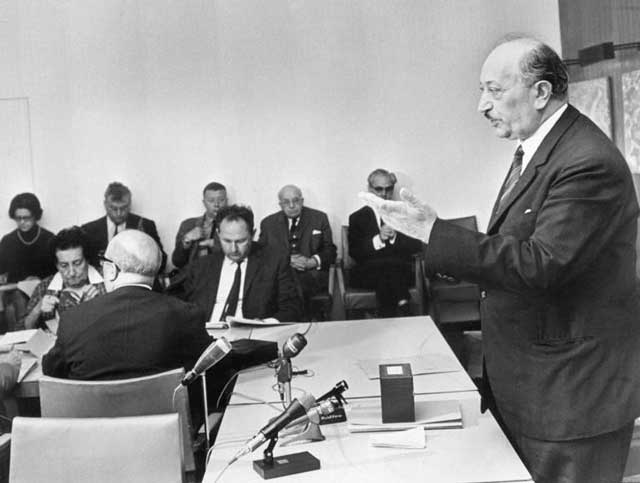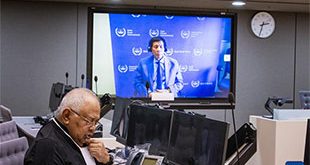
Paris, France | AFP | On May 11, 1960, Nazi war criminal Adolf Eichmann was nabbed by a team of Israeli spies after years on the run in Argentina, ending a long manhunt.
Ten days later, drugged and dressed as a crew member of Israeli flag carrier El Al, he was smuggled to Israel by Mossad agents and put on trial.
The architect of the Nazis’ “Final Solution”, under which six million European Jews were exterminated during World War II, Eichmann was tried and hanged in 1962, aged 56.
Here is an account, based on AFP coverage from the time and since, of the top secret operation, details of which filtered out over the years.
– ‘War criminal arrested by Israelis’ –
“The security services found one of the great Nazi war criminals, Adolf Eichmann,” prime minister David Ben Gurion announced on May 23, adding that he was under arrest in Israel and would face trial, in a masterstroke hailed by the Israeli press.
Eichmann’s name and his role as architect of the Nazis’ killing machine had surfaced during the Nuremberg war crimes trials which took place from 1945-1946.
He had been charged with organising and coordinating the deportation of Jews to death camps in Eastern Europe.
The former chief of Section IV B.4 of the Gestapo, responsible for the so-called “Jewish question”, had vanished after the “Third Reich” collapsed in May 1945.
Before fleeing he had destroyed documentary evidence of his activities and photos that could identify him.
– The Argentinian lead –
A manhunt was launched in 1945, led by prominent figures in the Jewish community, including famous Nazi hunter Simon Wiesenthal, who himself had escaped a concentration camp.
The breakthrough came in 1957 when the prosecutor of the German state of Hesse, Fritz Bauer, tipped off the Israeli secret service that Eichmann was in hiding in Argentina, under the false name of Ricardo Klement.
It took Mossad more than two years to locate him, living in a home without running water and electricity in the neighbourhood of San Fernando on the outskirts of Buenos Aires.
During a March 1960 mission Mossad agents, using photos, formally established that Ricardo Klement was the former lieutenant-colonel Eichmann.
Mossad spy Tzvi Aharoni, who shadowed him and sat behind him on a bus said: “The temptation to lean forward and strangle him was almost irresistible.
“But I knew he had to be put on trial and not be assassinated for those he had killed,” he told AFP.
– A thriller unfolds –
With Ben Gurion’s green light, the abduction was planned meticulously under the leadership of the Israeli secret service chief Isser Harel.
The mission was given to Mossad operative Rafi Eitan, who later recalled: “When I was given this mission, I knew that if we succeeded, we would enter Israel’s history and the history of humanity.”
The abduction was set for May 11. A foreman at a Mercedes-Benz factory, Eichmann returned every evening to his home on Garibaldi Street, taking the same bus at the same time.
Shortly after 8:05 pm he was nabbed as he got off the bus. He put up some resistance, and called for help before being dragged into a car and hidden under a blanket.
Eichmann shouted in German to his abductors: “I have already accepted my fate.”
He was taken to a safe house rented for the mission, where he was chained to a bed and blindfolded.
In an interview with AFP, Eitan later said: “I blindfolded him and checked his scars. When I was sure it was him, I shook my colleague’s hand and told him: ‘We’ve accomplished our mission’.”
On May 20, the Mossad squad took him on a false Israeli passport on a special plane used by the Israeli delegation which had come to celebrate the 150th anniversary of Argentina’s independence.
– ‘The banality of evil’ –
On April 11, 1961 the captured Eichmann, facing 15 charges, appeared for the first time in public in a glass booth in a Jerusalem court, which would question some 111 witnesses.
“Wearing a black suit, a dark tie over a white shirt and large horn-rimmed glasses, the accused, ashen, clean shaven and tight-lipped, entered at 9:00 am in the glass box reserved for him,” AFP wrote.
Writer Haim Gouri said: “The trial gave the survivors of the genocide, for the first time, the possibility of being heard.”
Some 450 foreign journalists, 100 observers and diplomats attended the different hearings.
Among them was author and concentration camp survivor Elie Wiesel and American Jewish philosopher Hannah Arendt, who published in 1963 a major book on the subject, “Eichmann in Jerusalem: A Report on the Banality of Evil”.
Eichmann was sentenced to death on December 15 after being convicted on all counts, including crimes against the Jewish people, crimes against humanity and war crimes.
On May 29, 1962, his appeal was rejected by the Supreme Court.
He was hanged on May 31 at midnight and his ashes were scattered at sea.
 The Independent Uganda: You get the Truth we Pay the Price
The Independent Uganda: You get the Truth we Pay the Price


